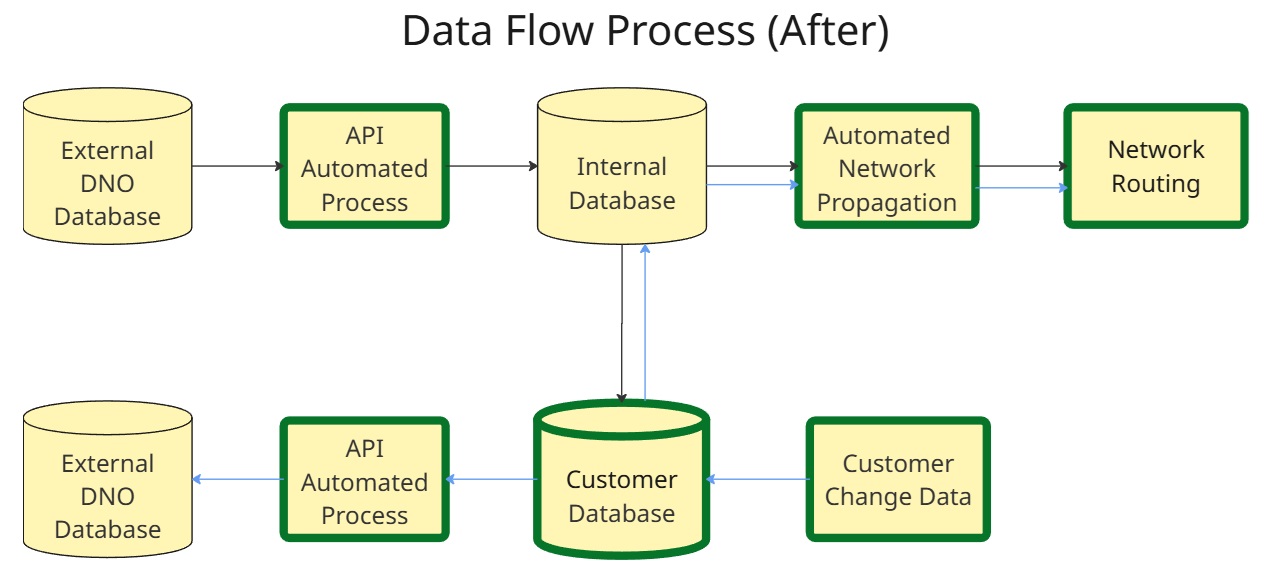Detailed Breakdown
The Problem:
In 2022, the FCC mandated that all Gateway Providers — those serving as the entry point for foreign calls into the US — must block calls originating from numbers on any "reasonable" Do Not Originate (DNO) list. Eventually this requirement was expanded to all voice providers in the United States. While we were compliant using a rudimentary, manually-updated list from the Industry Traceback Group (ITG), it was not as comprehensive or dynamic as other third-party solutions, representing a potential area of risk and inefficiency. In addition, discussions with customers quickly unveiled the need for a more dynamic tool where they could manually opt-in their own numbers as needed.
The Opportunity:
This presented a two-fold opportunity. First, we could enhance our compliance posture and demonstrate our commitment to ecosystem health by automating our processes and integrating a more robust, dynamic, and complete third-party DNO list. Second, we could productize this capability and offer a new DNO protection service to our own customers, allowing them to safeguard their numbers from being spoofed by designating them "inbound only" to other voice providers in the industry.
Target Persona:
The project targeted two distinct groups:
1) Our Internal Engineering team who would benefit from automated, more reliable DNO list management.
2) All Service Provider Customers (e.g., call centers, businesses with inbound-only numbers) who needed a solution to prevent their numbers from being used in fraudulent outbound calling campaigns on our network or any other network in the United States.
Key Insights:
Our internal analysis showed that the immediate, incremental benefit of blocking more calls by switching to the new list was relatively small. However, the strategic value was immense. It showed a commitment beyond minimum compliance and leveraged the unique industry position of a third-party provider. The most significant insight was the potential to create a near-100% margin, revenue-generating product from a compliance-driven initiative.
Product Vision:
To transform a mandatory compliance function into a strategic asset by automating our internal DNO process and launching a new, self-service DNO protection product for our customers, reinforcing our role as a leader in robocall mitigation.

Strategic Roadmap:
I designed a PRD with a two phases:
• Phase 1: Internal Automation. Integrate with the third-party DNO provider to replace our manual ITG list process with a dynamic, automated system.
• Phase 2: Customer-Facing Product. Build a portal for customers to manage and submit their own inbound-only numbers to the DNO list, creating a revenue-generating robocall mitigation service.
Solution:
The designed solution involved two key workstreams. Internally, our systems would be configured to pull the DNO list from the new provider via a real-time API. Externally, we would develop a simple, intuitive customer portal where users could upload and manage lists of their inbound-only numbers, which would then be fed into the same DNO service for protection across the ecosystem.

Key Features:
Internal Automation:
• Automated API integration with third-party DNO list provider.
• Current list availability provided in a snowflake database.
• Real-time updating of blocking rules on our gateway and routing network elements.
Customer DNO Service:
• Build a customer portal for self-service.
• Ability for customers to add, view, and remove their inbound-only numbers.
• Reporting to show customers when their numbers were protected.
Process & Collaboration:
As the author of the PRD, my role was to define the vision along with the "who" "why" and "what" of the project. I conducted the analysis to identify the opportunity, outlined the business case, defined the features and user journey, and worked with Engineering to validate the technical feasibility. The PRD served as the blueprint for the project, aligning all stakeholders across the business from Leadership to Engineering.
Results & Impact:
While the project was fully designed, it never launched due to shifting priorities. The business case was clearly compelling because the costs were negligible as the core infrastructure was already in place. The new DNO service was projected to be a near-100% margin product, turning a compliance necessity into a source of profitable growth.
Reflection:
This project was a masterclass in product strategy — finding the hidden opportunity within a regulatory mandate. It proved that with the right perspective, compliance-driven work doesn't have to be just a cost center. I learned the power of a well-researched PRD to align an entire organization around a vision, even if external factors prevent its ultimate launch. I anticipate this effort will continue at some point in the near future.